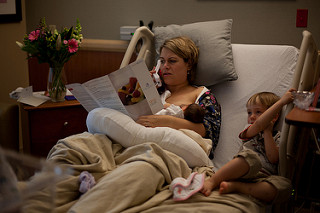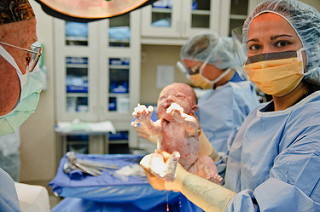Is a C-Section or Natural Birth Better?

Many women prefer to have a c-section, sometimes out of fear. However, the truth is that childbirth must be based on the premise that birth is a physiological process in which one must only intervene to correct deviations from normalcy.
Giving birth naturally will allow you to recover better and faster to take care of your baby. A c-section is an operation and like all surgeries, it requires a recovery process and special care. So after undergoing a c-section, you will need special attention and the wound will be painful and take time to heal.
On the other hand, giving birth naturally allows you a faster recovery and to be ready for your baby. Ensure that those who attend your birth promote an environment of trust, security, and privacy, respecting your dignity and confidentiality. That will help you.
The Spanish Society of Gynecology and Obstetrics (SEGO) recommends active participation of women in their pregnancies, so that they have the power to make decisions regarding their health. Knowledge is light, do not forget it.
My body knows how to give birth.
How to breathe, digest, create, walk, talk, think.
It is perfectly designed for it:
My pelvis, my uterus, my vagina,
they are engineering works
at the service of the force of life.
-Mónica Manso, poet-
Information is key
You and your family should know in depth the reproductive period they are going through, get involved in the care you receive and actively participate in the moment of delivery.
Ideally, from the beginning of pregnancy, you and your partner should have information about the physiological process of motherhood and the ability that women develop to give birth naturally.
You should visit various health centers if need be, and consult the opinion of several doctors.
The professionals of SEGO suggest preventing uncertainties and fears surrounding pregnancy; they favor a satisfactory experience and a preference towards a normal delivery.

Awake and ready
There’s another important point. During delivery, you will be aware of what happens to you because you will be awake and not sedated as normally happens in cesarean sections. You can see your baby when it comes out of your belly and then hold it in your arms.
You can have people there during labor that support you throughout the process in an uninterrupted way. Ideally, this person, whom you must choose freely, will accompany you through the earliest stages of this process.
C-section as an option
The idea is not to demonize cesareans. It is just that you should think of it as an alternative that is used to correct circumstances or conditions that are unfavorable to natural childbirth, or that put your health or your child’s health at risk.
The World Health Organization (WHO) includes the cesarean section rate as an indicator of the quality of maternal and perinatal care.
In their 1985 recommendations, they referred to a cesarean section rate of 15% of deliveries, based on the number of women in whom life-threatening complications are anticipated during delivery.

The high cesarean rates may be due to potential maternal and neonatal complications, and entail higher costs and overmedication of a normal event such as delivery.
The rates of cesarean sections in Spain and in other European countries is high and is increasing progressively.
There are new factors that could be related to this increase, such as increasing the age of mothers, multiple births, requests from women and demands for suspected malpractice.
All these reasons are more than valid and ideally, like any event in your life, the choice of how you will bring your child to the world should be a conscious choice, based on your needs and taken with the greatest precision in the world.
This information will bring down unfounded myths and fears. Here I leave some recommendations written in a manual called “Important points for normal childbirth.” These tips are for those who attend the birth, but you can make them yours:
- Lean how to recognize the signs of true labor to reduce the number of on-call consultations for false labor.
- Help the pregnant woman adjust and choose to adopt a position according to her needs and preferences.
- Allow the intake of food, mainly liquids, according to the needs of the pregnant woman
- Promote friendly environments (natural, architectural and psycho-social) that help create an optimal attitude and experience
- Perform a monitoring and control of health
Many women prefer to have a c-section, sometimes out of fear. However, the truth is that childbirth must be based on the premise that birth is a physiological process in which one must only intervene to correct deviations from normalcy.
Giving birth naturally will allow you to recover better and faster to take care of your baby. A c-section is an operation and like all surgeries, it requires a recovery process and special care. So after undergoing a c-section, you will need special attention and the wound will be painful and take time to heal.
On the other hand, giving birth naturally allows you a faster recovery and to be ready for your baby. Ensure that those who attend your birth promote an environment of trust, security, and privacy, respecting your dignity and confidentiality. That will help you.
The Spanish Society of Gynecology and Obstetrics (SEGO) recommends active participation of women in their pregnancies, so that they have the power to make decisions regarding their health. Knowledge is light, do not forget it.
My body knows how to give birth.
How to breathe, digest, create, walk, talk, think.
It is perfectly designed for it:
My pelvis, my uterus, my vagina,
they are engineering works
at the service of the force of life.
-Mónica Manso, poet-
Information is key
You and your family should know in depth the reproductive period they are going through, get involved in the care you receive and actively participate in the moment of delivery.
Ideally, from the beginning of pregnancy, you and your partner should have information about the physiological process of motherhood and the ability that women develop to give birth naturally.
You should visit various health centers if need be, and consult the opinion of several doctors.
The professionals of SEGO suggest preventing uncertainties and fears surrounding pregnancy; they favor a satisfactory experience and a preference towards a normal delivery.

Awake and ready
There’s another important point. During delivery, you will be aware of what happens to you because you will be awake and not sedated as normally happens in cesarean sections. You can see your baby when it comes out of your belly and then hold it in your arms.
You can have people there during labor that support you throughout the process in an uninterrupted way. Ideally, this person, whom you must choose freely, will accompany you through the earliest stages of this process.
C-section as an option
The idea is not to demonize cesareans. It is just that you should think of it as an alternative that is used to correct circumstances or conditions that are unfavorable to natural childbirth, or that put your health or your child’s health at risk.
The World Health Organization (WHO) includes the cesarean section rate as an indicator of the quality of maternal and perinatal care.
In their 1985 recommendations, they referred to a cesarean section rate of 15% of deliveries, based on the number of women in whom life-threatening complications are anticipated during delivery.

The high cesarean rates may be due to potential maternal and neonatal complications, and entail higher costs and overmedication of a normal event such as delivery.
The rates of cesarean sections in Spain and in other European countries is high and is increasing progressively.
There are new factors that could be related to this increase, such as increasing the age of mothers, multiple births, requests from women and demands for suspected malpractice.
All these reasons are more than valid and ideally, like any event in your life, the choice of how you will bring your child to the world should be a conscious choice, based on your needs and taken with the greatest precision in the world.
This information will bring down unfounded myths and fears. Here I leave some recommendations written in a manual called “Important points for normal childbirth.” These tips are for those who attend the birth, but you can make them yours:
- Lean how to recognize the signs of true labor to reduce the number of on-call consultations for false labor.
- Help the pregnant woman adjust and choose to adopt a position according to her needs and preferences.
- Allow the intake of food, mainly liquids, according to the needs of the pregnant woman
- Promote friendly environments (natural, architectural and psycho-social) that help create an optimal attitude and experience
- Perform a monitoring and control of health
All cited sources were thoroughly reviewed by our team to ensure their quality, reliability, currency, and validity. The bibliography of this article was considered reliable and of academic or scientific accuracy.
- Betran, A. P., Torloni, M. R., Zhang, J., Ye, J., Mikolajczyk, R., Deneux-Tharaux, C., … & Gülmezoglu, A. M. (2015). What is the optimal rate of caesarean section at population level? A systematic review of ecologic studies. Reproductive health, 12(1), 1-10. https://reproductive-health-journal.biomedcentral.com/articles/10.1186/s12978-015-0043-6?report=reader
- Betrán, A. P., Torloni, M. R., Zhang, J. J., Gülmezoglu, A. M., Aleem, H. A., Althabe, F., … & Zongo, A. (2016). WHO statement on caesarean section rates. Bjog, 123(5), 667. https://www.ncbi.nlm.nih.gov/pmc/articles/PMC5034743/
- Bosch, A. A., Levin, E., van Houten, M. A., Hasrat, R., Kalkman, G., Biesbroek, G., … & Bogaert, D. (2016). Development of upper respiratory tract microbiota in infancy is affected by mode of delivery. EBioMedicine, 9, 336-345. https://www.thelancet.com/article/S2352-3964(16)30225-0/abstract
- García-Benitez, C. Q., de Jesús López-Rioja, M., & Monzalbo-Núñez, D. E. (2015). Parto después de cesárea¿ una opción segura?. Ginecología y Obstetricia de México, 83(02), 69-87. https://www.medigraphic.com/cgi-bin/new/resumen.cgi?IDARTICULO=56694
- Hobbs, A. J., Mannion, C. A., McDonald, S. W., Brockway, M., & Tough, S. C. (2016). The impact of caesarean section on breastfeeding initiation, duration and difficulties in the first four months postpartum. BMC pregnancy and childbirth, 16(1), 1-9. https://bmcpregnancychildbirth.biomedcentral.com/articles/10.1186/s12884-016-0876-1
- Kennedy, C. E., Yeh, P. T., Pandey, S., Betran, A. P., & Narasimhan, M. (2017). Elective cesarean section for women living with HIV: a systematic review of risks and benefits. AIDS (London, England), 31(11), 1579. https://www.ncbi.nlm.nih.gov/pmc/articles/PMC5491238/
- Maneschi, F., Biccirè, D., Santangelo, G., Perrone, S., Scaini, A., & Cosentino, C. (2017). Implementation of the four-category classification of cesarean section urgency in clinical practice. a prospective study. Gynecologic and obstetric investigation, 82(4), 371-375. https://karger.com/goi/article/82/4/371/161448
- Mylonas, I., & Friese, K. (2015). Indications for and risks of elective cesarean section. Deutsches Ärzteblatt International, 112(29-30), 489. https://www.ncbi.nlm.nih.gov/pmc/articles/PMC4555060/
- Nanji, J. A., & Carvalho, B. (2020). Pain management during labor and vaginal birth. Best Practice & Research Clinical Obstetrics & Gynaecology, 67, 100-112. https://www.sciencedirect.com/science/article/pii/S1521693420300432
- Sandall, J., Tribe, R. M., Avery, L., Mola, G., Visser, G. H., Homer, C. S., … & Temmerman, M. (2018). Short-term and long-term effects of caesarean section on the health of women and children. The Lancet, 392(10155), 1349-1357. https://www.thelancet.com/journals/lancet/article/PIIS0140-6736(18)31930-5/fulltext
This text is provided for informational purposes only and does not replace consultation with a professional. If in doubt, consult your specialist.








